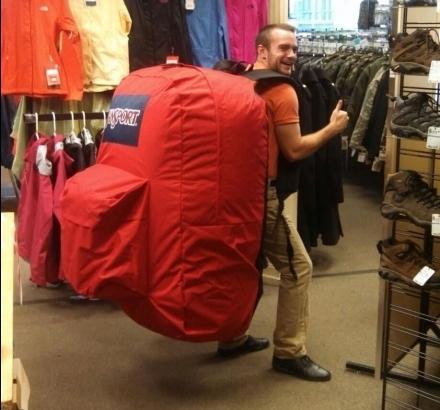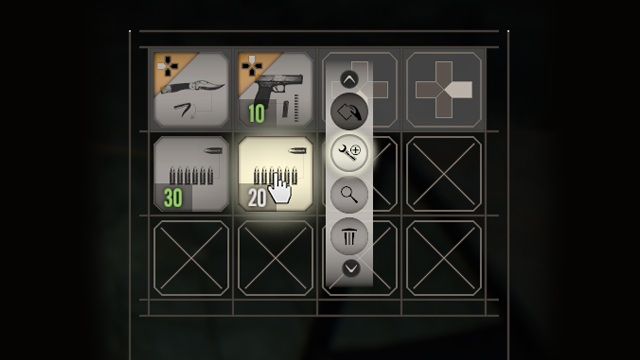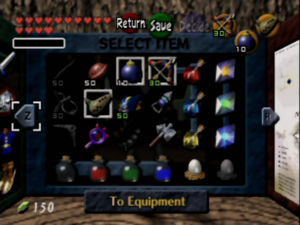Trending
Opinion: How will Project 2025 impact game developers?
The Heritage Foundation's manifesto for the possible next administration could do great harm to many, including large portions of the game development community.

Featured Blog | This community-written post highlights the best of what the game industry has to offer. Read more like it on the Game Developer Blogs or learn how to Submit Your Own Blog Post
People love to collect, especially when a game system allows it. Developers have an unspoken duty to manage a player's desire to pick up every little thing they find in their worlds. As numerous titles have shown, there are a number of ways to do this.


Many people like to collect. It is a compulsion, a hobby, maybe even an instinct. Video games these days have noticed this behavior. If players love to scavenger hunt whenever they pick up a controller, then developers have a responsibility to manage this compulsion. How does a developer do this; put systems in place to manage or outright prevent players from hoarding? They usually either limit the player to encourage them to think about what they carry, or they encourage the player to grab all that they can find. The most important thing a developer needs to figure out is when to do one or the other. When it is fine to let a pack rat roam free?
Not all systems are made equal. Everyone knows it, so how can designers put real thought into what motivates/demotivates collecting? Firstly, the system must provide a reward of some kind. Someone could dive into unknown territory and find a secret item, or they could trade in stockpiled junk for either upgrades or unique items. Suddenly picking up everything in sight is not so wasteful.
Collecting a bunch of worthless junk is going to get tedious fast. As many items in the system as possible must have a clear function or purpose. Collecting different scraps that can be transformed into something bigger or collecting special items that unlock rewards upon discovery is much more worth a player’s time.
Not only should items be purposeful, but they should clearly have worth. In-game currency is always a better incentive than a souvenir that can merely be observed. Unique limited currencies tend to be more interesting finds, and most game systems know to keep those currencies at either a relatively small number, or have the goal to acquire it be varied and interesting. Novelties are still fine, but there must be more to discover. With all this in mind, tedium can still creep through the cracks if there are too many small things scattered across a world to realistically keep track of.
Regardless of if the game is fast or slow paced in a relative sense, playing a game should not feel like a chore. The developer can get around this by either keeping the actual amount small, or by centering an interesting mechanic/mini game around it. Similarly, if a game developer decides to place limits on what or how much a player can carry, that player is more willing to accept the limitation if there is a clear dynamic at work. Whether it’s because the item in question is a special bonus or a valuable tool, if a developer can put as much love into the rewards as the rest of the game, then players will be willing to seek it out. Many games have already come up with interesting solutions to these problems, so it helps to play games with clear inventories and item collecting systems and see how they are integrated into the game system.

Role-playing games are almost expected to provide a wide variety of options. Item collecting, especially in modern times, is not exempt from this. The Elder Scrolls franchise has limited what the player can carry ever since its early days. How punishing this is depends on the title.
In the earlier installments, a single piece of armor or weapon could take up as much as a tenth of a player’s capacity. What happens when a player is over-encumbered? They cannot move period. Suddenly the player must think about what they are carrying; they learn to take only what matters and prioritize looting either deceased enemies or buildings based on their character build. The fifth installment, Skyrim, decided to add some form of mercy. In that title, the player still cannot fast travel when carrying a heavy load, but they can still walk, and if they can find a horse, they can fast travel once more. This helps to make another Elder Scrolls staple more manageable: home ownership.

One of the biggest incentives for a pack-rat in the Elder Scrolls games is to collect all the weapons, notes, books, etc. that the game offers through its many quests. Once a player acquires a home, they are provided numerous containers that can store any and all trinkets the player finds. On top of this, a time-honored tradition of decorating player homes with the items they find, including misc. pots and pans provides an additional purpose to even the smallest game item. It is a form of player expression.
Skyrim provided additional functionality to homes via display cases, weapon racks, and bookcases. (In fact, Skyrim’s home mechanics is worth an article by itself.) Most of these items? Powerful weapons and armor, valuable jewels and trinkets that can be sold to in-game merchants for significant coin, in-game books containing interesting lore, and much more.
Bethesda has successfully injected incentive by providing plenty of unique weapons, items, and a nice place to put it all. Players just need to be mindful of how much they hold at any one time. Thankfully, this can be upgraded as the game progresses, and some items are extremely light or, like lock picks or money, have no in-game weight.

The original System Shock, while not a mega blockbuster, is a cult classic first-person shooter game that was ahead of its time in terms of first-person gameplay, environmental storytelling, and helped to influence future titles such as Deus Ex. The sequel, System Shock 2, another cult classic, was even more influential and improved in just about every way what the original succeeded at.
Much like modern Elder Scrolls titles, inventory is limited, and items are found either on dead bodies, in containers or out in the open. System Shock 2’s inventory is a somewhat grid-based menu where different items take up different amounts of space. Weapons and especially armor take up the most space, while standard items take up as little as one space.
Survival horror titles such as this also often heavily emphasis putting real thought into what the player is carrying. System Shock 2 not only accomplishes this by limiting the inventory, but also with its RPG-like upgrade systems. Many items in the game are only useful to a player if they have the relevant skill levels.
The special currency that unlocks these skill upgrades are in short supply, meaning that pack-rats are going to have an interesting time here. Thankfully, not all is lost, as the game encourages the player to work to their strengths, whether it be hacking, psionic powers, or standard weaponry. Standard game currency is not too hard to find, and if the player maintains their curiosity, they can find not only helpful items like cyber-chips that can provide necessary skill upgrades when equipped, but also temporary stat boosters and more of the currency needed for skill upgrades. There is also within the game an item that eats trash in your inventory and spits out a bit of currency.
On top of this, every single item in the game has an interesting description to it that helps expand the world the story takes place in. Finally, the audio logs, another staple of modern games, help tell the story of the world around the player in a unique non-linear format. This game can be challenging to pack-rats, but the experience it provides is worth the trouble and pack-rats can still get their fix with all the items that they can find if they look close enough.

Resident Evil 4 breathed new life into the third-person shooter genre and is often hailed as one of the sixth generation of games' landmark titles. One mechanic that many look back on with fondness is the inventory system.
As with most Resident Evil games, player inventory is limited. In this game, it’s an on-going puzzle not unlike System Shock 2’s inventory. The visual representation of a cache works on a grid system where every item takes up a set amount of space. It is possible to maneuver the items around the inventory to make room, such as rotating them and moving them, but even so if players do not exercise caution, they will find themselves ill-prepared for the more aggressive enemies of this installment.
In contrast to previous games, enemies drop items upon defeat, and there are plenty of items to acquire both in containers and in the open. This makes it easy to lose track of carrying capacity. The player could decide to prioritize only healing items and ammunition for the weapons on their person (which also take up inventory space).
Conversely, perhaps they’ll always leave room for extra items such as more potent healing items like fish and eggs, or different grenades for tight situations. Sometimes they might find a new weapon out in the open. However, currency and treasure do not take up inventory space. These treasures can be sold to the in-game merchant for more coin to buy both new weapons and upgrade on-hand equipment. There are also inventory upgrades to watch out for.
Patience is often encouraged, as some in-game treasures can be combined to be sold at higher prices, and since the game provides more than enough opportunities to collect things, a player can either choose to work with what they are given or prioritize saving money to afford upgrades. Proceeding with caution is advised as most of the more powerful equipment takes up the most space.

When Capcom revitalized the Resident Evil franchise after the polarizing reception of the severely action-oriented Resident Evil 6, they went back to the franchise’s roots established in the 1996 original. One of these roots was the inventory.
In these games, the player’s max capacity is often as low as 8-10 items in the beginning. This includes weapons and any keys or items. Nearly every enemy takes a significant amount of damage to eliminate, forcing players to consider which enemies are worth taking down. This is an even more vital task than before as enemies do not drop items.
In boss fights, while sometimes items are provided to keep the flow, not exercising conservation will often severely hurt the player’s chance of success. On the harder difficulties of both games, certain items are needed to even save progress. Unfortunately, even the items involved in puzzles take up space. The mechanic of checking items to either get an idea of their purpose or to activate them also makes a return. Both games also feature modern design tastes such as weapon upgrades, inventory upgrades, and on occasion player upgrades (although these are very few and far in-between.)

Inventory is only occasionally a puzzle, as certain powerful tools will take up two inventory spaces, and both titles also include basic item crafting from combining two items. This yields powerful ammo and healing items, but the pieces needed for upgrading are also in short supply, and often the same items can be combined with different items for different results.
There usually aren’t too many treasures, but these do exist in the form of bonuses for repeat playthroughs and in the case of the Resident Evil 2 remake, concept art and in-game models. Weapon upgrades in this title will cause a weapon to take up more inventory space, adding another layer of strategy as a player decides which upgrade is worth keeping.

In Naughty Dog’s foray into survival horror, the rules are familiar but thankfully are not too complicated.
Like standard Resident Evil games, resources are extremely limited. Often only single bullets can be found for guns, and enemies are ruthless whether they be infected or normal humans. Thankfully, the game provides other options.
Enemies can be taken down through a combination of melee and stealth to conserve resources, which the game highly encourages. On top of this, helpful tools like shivs and smoke bombs can be crafted but it must be done in real time and the ingredients are not only found in bits, but the same ingredient can be used to make different things, forcing players to prioritize. Pack-ratting is almost vital in this game.
It’s not all gloomy, as there are also supplements and scraps to find to upgrade weaponry and skills. Furthermore, not only are there interesting stories to discover through the notes in the game, a tradition these days, but also unlockable bonuses via currency earned from completing in-game challenges. The Last of Us does not necessarily innovate much, but the way in which it applies simple survival mechanics leads to an interesting experience that at least partially revolves around pack-ratting.

This franchise practically defined action-adventure, while also inspiring future role-playing games. Nearly every game starts the player out with nothing but a sword and shield. As they progress, they find and earn money, and numerous useful gadgets and items.
Every major item has a clearly defined purpose, the best ones can be used for both puzzles and combat, from the iconic hook-shot and mirror shield to a giant hammer and even magic staffs. Most titles also yield items that are required to progress through the game, and the inventory screens often serve as a reminder of how far the player has come and how far they need to go.
Thankfully, despite being longer than an average AAA title, the number of unique items is just enough to encourage a player to collect them, but not so many that it becomes a chore. Zelda usually provides the players incentive by giving them things to look forward to. The player is a versatile warrior, and the game shows them that no matter what, either they have the right tool for the job, or the right tool is out there somewhere for them to find. Throw in the occasional upgrade, and pack-rats have all that they need to explore Hyrule’s many locales and incarnations.
Breath of the Wild was one of the freshest installments in the Zelda series. The base mechanics that makes Zelda games great are here, but item management has become vary reminiscent of other open world titles such as The Elder Scrolls.
Equipment capacity is quite limited, and each category of equipment has a separate limit placed on it which also needs to be upgraded individually. Furthermore, all equipment excluding apparel breaks after repeated use. Keeping with the numerous survival mechanics present in the game, players not only need to decide which equipment is worth carrying, but also when is the best time to use it. This naturally is a large contributing factor to the game’s relatively high challenge.
Enemies and numerous items in the world yield money and ingredients for crafting and cooking, but it is no easy journey with limited health and stamina. Thankfully to balance things out, players can carry far more items overall, often nearly 100 of each item, of which there are many. Food can either be consumed outright or mixed to create potent dishes which unique temporary status buffs.
Pack-ratting is a double edged-sword in this game. A player can collect numerous foods and items to their heart’s content, many of which can be sold for significant money. On top of that, there is a variety of clothing to acquire with different stats which don’t weigh the player down. Conversely, weaponry is often limited and fragile, so an element of strategy is still very much required. On top of this, there are numerous opportunities for improvement, and often the most dangerous enemies drop the strongest equipment, which incentives players to stand up to the challenge and master the game mechanics.
The few item types that provide upgrades are a grand reward that a player simply cannot pass up in this brutal world. At the same time, the game is extremely flexible and provides numerous opportunities to tackle boundaries in any way the player can think of. The game constantly reminds players that, if they explore and stand up to the challenge, they will be rewarded. Pack-ratting is always a grand time here.

Some video games take a simpler approach. Saints Row 2 decides to give the player a virtual playground full of whacky content. This sequel helped differentiate it from its more familiar competition (GTA) via a more light-hearted, comedic approach. Every major mission and activity within this game not only provides a roaring great time, but they also provide worthwhile rewards. These range from character upgrades, to cool vehicles, and crazy weapons such as shock paddles and a “pimp-cane” shotgun.
The only real inventory is found in the weapons wheel and food available. There are also the standard shops that sell clothing, weapons, etc. Pack-ratting is not the first thing most people would think of when they think of a sandbox third person shooting game, but the fact is that Saints Row 2 provides so many secrets to uncover that it compels players to look everywhere and do everything in the virtual world.
A secret lab, a crazy gun, or a sweet piece of clothing is always there to be found. Furthermore, the amount of customization offered to the player via custom outfits, vehicle customization, and a personal garage for any and all cars found in the world helps players to express themselves and immerse in a fantasy world where they are the wealthy gang kingpin of the city.

There are some games out there that not only successfully implement previous systems but that which also prove that a little innovation goes a long way. Super Mario Odyssey made one of the franchise’s boldest moves by removing the lives system. At the same time, a consequence for error still needed to be implemented. So, when a player dies in Odyssey, they lose 10 coins and are sent back to the last checkpoint (usually near where they died if in the overworld of the area).
Players probably wouldn’t put much thought into coins in a typical Mario game, so to remove the system that made coins relevant, 100 coins giving an extra life, something else had to take the place of lives to incentivize them to want to keep coins on them. This comes in the form of the shops. In a shop, a player can trade in coins for not only some extra power moons (the item that progresses the game, a staple mechanic found in most 3D Mario games) but also unique clothing that Mario can wear. They do not offer any benefits, but they are undeniably charming.
The simple concept of playing dress-up remains endearing to most, and players bothered with it because it was almost entirely optional. Players can also buy hints for acquiring certain power moons and pay NPCs that offer mini games that provide power moons. Coins are a genuine currency system in this Mario title, and the developers decided to not only populate the game with coins, as per usual, but also include secret tough to reach stockpiles of coins, along with the occasional coin mini game.
Coins suddenly had a more genuine reason to exist. There are also special purple coins, different types in each world, that not only pay for special outfits but also souvenirs for the in-game ship.
The biggest gameplay change in Odyssey is the return of Super Mario 64’s non-linear approach to tasks. In 64, players could acquire Power Stars out of the intended order leading to unique play styles. Odyssey takes this one step further by creating courses in the style of a sandbox game, in general it doesn’t matter what you do in each area as so long as you acquire the right number of power moons.
Breaking down constraints while also widening (but not outright removing) the boundaries further encourages a player to absorb their surroundings and explore everywhere they can for whatever the game offers. Sometimes it only takes a few tweaks to bring new life into a long-running series.

Often considered a spiritual successor of sorts to System Shock 2, Bioshock was a massively successful and highly acclaimed first-person video game that took almost every design element of System Shock and simplified it to reach a broader audience of players.
The inventory in this game is quite basic, the total power source of special abilities and health items are integrated into the health and EVE meters, and the weapons and powers on hand are all self-contained into a cycling wheel. Any container or body in this game will only ever have three items on hand at once. Furthermore, powers and abilities cannot all be wielded at once and must be chosen between.
Most of these items are identical to those found in System Shock, from food and items that provide upgrades, to ammunition and in-game money. These items however are abundant. Bioshock does still limit how much a player carries at one time, but the RPG elements of System Shock are no longer present. There is no inventory management, and the player can use every weapon that the world presents so most pack-rats can rest easy. Looking for upgrades, special ammo, and data logs is still a grand time here, but there is also a new mechanic of inventing items.
Scraps are now found in containers and on enemies. These scraps can be used to build some of the most helpful items and ammo in the game. Of course, those same items can be found via exploring but they are rare.

However, the most brutal mechanic, and one of the most essential to the game’s narrative, is ADAM. ADAM is the special currency of this game that unlocks more powerful abilities and upgrades. The problem is that acquiring ADAM is completely optional, even though the game does encourage the player to acquire it. If that wasn’t enough, it affects the outcome of the game. You acquire the most ADAM by killing the young girls that produce it. If you choose to spare them, you still receive ADAM but not as much. To balance this out, every three girls you save gets you a gift of significant ADAM and some new powers.
Pack-rats are therefore not only presented a more simplified version of System Shock 2’s item system, but also a new scrap mechanic and an interesting risk vs. reward system of player improvement. Players are forced to stop and think about whether they want to pack-rat as usual or find another way around the challenges provided.
There are many other games out there that provide different answers. It is ultimately up to the designer whether they want to encourage players to collect or dissuade them from carrying what isn’t needed. Some game systems set up simple rules for filling an inventory, while others turn it into an interesting puzzle or management mechanic. Other titles decide to let the player roam free while also giving them spaces to organize or clean up their hordes of treasures. Regardless of how a game is set up to accommodate them, players that love to pack-rat, collect neat things, or record their grand journey can fulfill these needs through all sorts of different titles from many different genres. As games advance, so too will the novelty of discovery and collecting. Developers will keep on experimenting and create new systems to truly make a game more than worth the cost of play.
Read more about:
Featured BlogsYou May Also Like